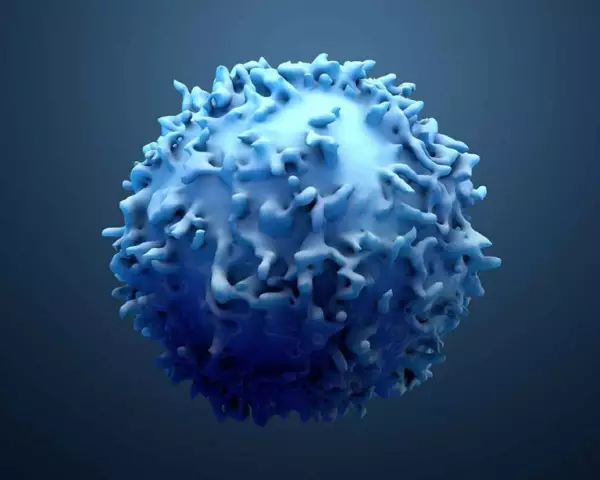- Author Curtis Blomfield [email protected].
- Public 2023-12-16 20:44.
- Last modified 2025-01-23 17:01.
Lymphocytes (white blood cells) - one of the subspecies of leukocytes, are the most important element of our immune system. They are formed in the bone marrow, their main function is the recognition of foreign antigens and the formation of protective antibodies in our body. Normally, human peripheral blood contains 18-40% of lymphocytes.

In preschool children (5-7 years old), the number of lymphocytes prevails over other types of leukocytes, with adulthood this ratio changes, and neutrophils increase, as in an adult. Therefore, the decoding of analyzes in children is carried out according to other criteria. With various infectious, oncological, autoimmune, allergic diseases and transplant conflicts, the number of lymphocytes in the blood changes.
Absolute lymphopenia (low lymphocytes)
Observed when an acute infectious disease occurs - at the initial stage, toxic substances migrate from blood vessels to tissueshuman body. Reduced lymphocytes indicate the presence of tuberculosis, purulent process, aplastic anemia, chlorosis, lupus erythematosus, Cushing's disease, genetic immune diseases, pneumonia, tumor-like lesions of internal organs. This is also observed with a clear violation of metabolic processes, renal failure, the toxic effects of alcohol and drugs, cirrhosis of the liver.
In the above diseases, lymphocytes are reduced. The causes of this phenomenon are due to inflammatory and infectious processes in the body. To identify the true cause, you need to contact a therapist, undergo an examination, and after the diagnosis, the doctor will prescribe the appropriate treatment, or refer you to highly specialized specialists: an infectious disease specialist, a hematologist, an oncologist.

Decreased lymphocytes in children
Lymphopenia appears in congenital immunodeficiency disorders. It can be passed on to the fetus while still in the womb. The most common cause is a poor protein diet. In some cases, lymphocytes in the blood are lowered in the presence of AIDS, in which the affected T-bodies are destroyed. Lymphopenia can occur with enteropathy, rheumatoid arthritis, and myasthenia gravis. Acquired and congenital immunodeficiency states are characterized by absolute lymphopenia, which occurs against the background of leukemia, neutrophilia, leukocytosis and exposure to ionizing radiation.
It has been established that the occurrence of absolute lymphopenia is observed in infants of postnatal andgestational ages. The disease is diagnosed in the first week of a baby's life. This is a very dangerous disease with a high risk of mortality in newborns. Most often, lymphopenia is asymptomatic, but in the case of cellular immunodeficiency, there is a decrease or absence of lymph nodes (tonsils). Pyoderma, eczema, alopecia, petechiae, jaundice, pallor of the skin may also appear.

In order to accurately diagnose low lymphocytes in a child's body, it is necessary to donate blood on an empty stomach. In newborns, blood is taken from the heel or capillaries of the leg or arm. If recurrent infections or lymphopenia are detected, intravenous immunoglobulin is indicated. Children with congenital immunodeficiency may be recommended for stem cell transplantation.






